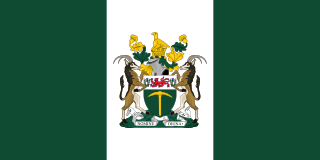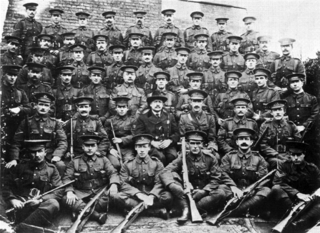Related Research Articles

Rhodesia, officially from 1970 the Republic of Rhodesia, was an unrecognised state in Southern Africa from 1965 to 1979. During this fourteen-year period, Rhodesia served as the de facto successor state to the British colony of Southern Rhodesia, and in 1980 it became modern day Zimbabwe.

The Selous Scouts was a special forces unit of the Rhodesian Army that operated during the Rhodesian Bush War from 1973 until the reconstitution of the country as Zimbabwe in 1980. It was mainly responsible for infiltrating the black majority population of Rhodesia and collecting intelligence on insurgents so that they could be attacked by regular elements of the security forces. The unit did this by forming small teams that posed as insurgents and usually included captured insurgents. Over time, the Selous Scouts increasingly attacked insurgents themselves and operated in the countries that neighboured Rhodesia.

The Rhodesian Bush War, also known as the Second Chimurenga as well as the Zimbabwe War of Independence, was a civil conflict from July 1964 to December 1979 in the unrecognised country of Rhodesia.

The British South Africa Police (BSAP) was, for most of its existence, the police force of Southern Rhodesia and Rhodesia. It was formed as a paramilitary force of mounted infantrymen in 1889 by Cecil Rhodes' British South Africa Company, from which it took its original name, the British South Africa Company's Police. Initially run directly by the company, it began to operate independently in 1896, at which time it also dropped "Company's" from its name. It thereafter served as Rhodesia's regular police force, retaining its name, until 1980, when it was superseded by the Zimbabwe Republic Police, soon after the country's reconstitution into Zimbabwe in April that year.

The Zimbabwe National Army (ZNA) is the primary branch of the Zimbabwe Defence Forces responsible for land-oriented military operations. It is the largest service branch under the Zimbabwean Joint Operations Command (JOC). The modern army has its roots in the Rhodesian Army, which was raised between 1963 and 1964 after the breakup of the Federation of Rhodesia and Nyasaland. A Joint High Command created in March 1980 to oversee integration of the formerly belligerent Rhodesian Security Forces, Zimbabwe African National Liberation Army (ZANLA), and the Zimbabwe People's Revolutionary Army (ZIPRA) officially established the Zimbabwe National Army in late 1980, nearly a year after the end of the Rhodesian Bush War.

The Rhodesian African Rifles (RAR) was a regiment of the Rhodesian Army. The ranks of the RAR were recruited from the black African population, although officers were generally from the white population. The regiment was formed in May 1940 in the British colony of Southern Rhodesia.

The 1st Battalion, Rhodesian Light Infantry (1RLI), commonly The Rhodesian Light Infantry (RLI), was a regiment formed in 1961 at Brady Barracks as a light infantry unit within the army of the Federation of Rhodesia and Nyasaland. Barely a year after its creation, it was relocated to Cranborne Barracks (Salisbury) where its headquarters remained for the rest of its existence. The Regiment became part of the Southern Rhodesian Army when the Federation dissolved at the start of 1964 and, later that year, reformed into a commando battalion.

The Rhodesian Security Forces were the military forces of the Rhodesian government. The Rhodesian Security Forces consisted of a ground force, the Rhodesian Air Force, the British South Africa Police, and various personnel affiliated to the Rhodesian Ministry of Internal Affairs. Despite the impact of economic and diplomatic sanctions, Rhodesia was able to develop and maintain a potent and professional military capability.

Air Rhodesia Flight 825 was a scheduled passenger flight that was shot down by the Zimbabwe People's Revolutionary Army (ZIPRA) on 3 September 1978, during the Rhodesian Bush War. The aircraft involved, a Vickers Viscount named the Hunyani, was flying the last leg of Air Rhodesia's regular scheduled service from Victoria Falls to the capital Salisbury, via the resort town of Kariba.

The Police Support Unit, also known by their nickname of the Black Boots, is a paramilitary wing of the Zimbabwe Republic Police. They were founded as a native police force but later developed into a counter-insurgency unit of the British South Africa Police in Rhodesia during the Rhodesian Bush War. The unit was the only paramilitary unit retained by the Zimbabwe Republic Police after the country's reconstitution as Zimbabwe.

The 1st Battalion, The Rhodesian Light Infantry, commonly the Rhodesian Light Infantry, was originally formed in 1961 as a regiment of the army of the Federation of Rhodesia and Nyasaland. Raised as a light infantry unit at Brady Barracks, Bulawayo in Southern Rhodesia, the Regiment served in the Rhodesian Bush War as part of the Rhodesian Security Forces between 1964 and 1979, from 1965 under the unrecognised governments of Rhodesia and latterly, during the second half of 1979, Zimbabwe Rhodesia. The RLI remained active during an interim period under British control and then, from April 1980, within the armed forces of Zimbabwe, before disbanding on 31 October 1980.

The 1st Battalion, The Rhodesian Light Infantry, commonly the Rhodesian Light Infantry, served in the Rhodesian Bush War as part of the Rhodesian Security Forces between 1964 and 1979, under the unrecognised government of Rhodesia following its 1965 Unilateral Declaration of Independence from Britain. During the second half of 1979 it fought for Zimbabwe Rhodesia, a black majority-ruled version of the same state which also failed to win international recognition. After an interim period under British control from December 1979 to April 1980, the RLI briefly remained active within the armed forces of Zimbabwe, but did not see action under this government. It disbanded on 31 October 1980.

Southern Rhodesia, then a self-governing colony of the United Kingdom, sent two military units to fight with the Commonwealth armed forces in the Malayan Emergency of 1948–60, which pitted the Commonwealth against the Malayan National Liberation Army (MNLA), the military arm of the Malayan Communist Party. For two years, starting in March 1951, white Southern Rhodesian volunteers made up "C" Squadron of the Special Air Service (SAS). The Rhodesian African Rifles, in which black rank-and-filers and warrant officers were led by white officers, then served in Malaya from 1956 to 1958.

In August 1914, the United Kingdom declared war on the German Empire at the start of World War I. The settler society in Southern Rhodesia, then administered by the British South Africa Company, received the news with great patriotic enthusiasm. The Company administrator, Sir William Milton, wired the UK government saying, "All Rhodesia ... ready to do its duty". Although it supported Britain, the company was concerned about the possible financial implications for its chartered territory should it make direct commitments to the war effort, particularly at first. As a result, most of the colony's contribution to the war was made by Southern Rhodesians individually—not only those who volunteered to fight abroad, but also those who remained at home and raised funds to donate food, equipment and other supplies.
The 1981 Entumbane uprising, also known as the Battle of Bulawayo or Entumbane II, occurred between 8 and 12 February 1981 in and around Bulawayo, Zimbabwe amid political tensions in the newly independent state. Zimbabwe People's Revolutionary Army (ZIPRA) guerrillas, mainly in the city's western suburb of Entumbane, rebelled, creating a situation that threatened to develop into a fresh civil war, barely a year after the end of the Bush War. The Rhodesian African Rifles (RAR) and other white-commanded elements of the former Rhodesian Security Forces, fighting for the Zimbabwean government as part of the new Zimbabwe National Army, put down the uprising. Groups of Zimbabwe African National Liberation Army (ZANLA) fighters attacked both ZIPRA and the government forces during the revolt, which followed a smaller outbreak of fighting between guerrillas in November 1980.

Southern Rhodesia, then a self-governing colony of the United Kingdom that was located in the now-independent Zimbabwe, entered World War II along with Britain shortly after the invasion of Poland in 1939. By the war's end, 26,121 Southern Rhodesians of all races had served in the armed forces, 8,390 of them overseas, operating in the European theatre, the Mediterranean and Middle East theatre, East Africa, Burma and elsewhere. The territory's most important contribution to the war is commonly held to be its contribution to the Empire Air Training Scheme (EATS), under which 8,235 British, Commonwealth and Allied airmen were trained in Southern Rhodesian flying schools. The colony's operational casualties numbered 916 killed and 483 wounded of all races.

Colonel Lionel DyckSCZ, also referred to as Colonel Dyck, was a Zimbabwean soldier and security contractor. He was born in 1944 in Southern Rhodesia and served with the Rhodesian Army and then the Zimbabwe Defence Forces before founding and leading companies such as the Dyck Advisory Group (DAG) which provided specialist security services including anti-poaching, demining and counterinsurgency.
Lieutenant Colonel John Charles Wyatt Aust, commonly known as Charlie Aust was a Rhodesian military commander. He was born in Enkeldoorn, Southern Rhodesia and was the last commanding officer of the Rhodesian Light Infantry (RLI).

Major-General G. A. D. "Andrew" Rawlins was a Rhodesian Army officer. He served in the Rhodesian African Rifles during the pre-independence years when Rhodesia was part of the British Federation of Rhodesia and Nyasaland. He remained in the unit following Rhodesia's unilateral declaration of independence in 1965. He was a proponent of psychological warfare in the early years of the Rhodesian Bush War but his proposals were not acted upon. In 1967 he recommended other changes in tactics to the Rhodesian chief of staff, Brigadier Keith Coster. Rawlins retired from the army as a brigadier in 1976 but was brought back to command, as a major general, the newly formed Guard Force. This unit was established to defend the protected villages, where the Rhodesian government had moved black civilians to isolate them from the guerrillas. He left this role in February 1977 to become the Rhodesian Army's director of psychological warfare. Rawlins left the army in 1979 as the Rhodesian Bush War was drawing to a close and ahead of the territory's transition into Zimbabwe.
Brigadier W. A. "Bill" Godwin was a Rhodesian army officer. He served with the Rhodesian African Rifles (RAR) during the British colonial era and was mentioned in despatches for service during the Malayan Emergency. After Rhodesia's 1965 unilateral declaration of independence from Britain Godwin remained with the RAR, rising to command its 1st battalion. By 1972 Godwin had reached the rank of brigadier and commanded Rhodesia's 2nd Brigade. He had retired by 1975 but was brought back to help establish Guard Force, a new armed service that provided security to the protected villages. The unit disbanded after the 1980 transition to black-majority government.
References
- ↑ Badcock, Peter (1980). Faces of War. Sygma. p. 8. ISBN 9780868760070.
- 1 2 3 Hartwell, Sheila (2018). My Zimbabwean Odyssey - The Sequel. ShieldCrest Publishing. p. 22. ISBN 9781912505418.
- ↑ Binda, Alexandre (2007). Masodja: The History of the Rhodesian African Rifles and Its Forerunner the Rhodesia Native Regiment. 30° South Publishers. pp. 77–89. ISBN 9781920143039.
- 1 2 3 Hemming, Eve (June 2013). Scatterlings- a Tapestry of Afri-Expat Tales. Xilbris. pp. 131–132. ISBN 9781483642291.
- ↑ Grobbelaar, Bruce (2018). "26". Life in a Jungle. deCoubertin Books. ISBN 978-1909245570.